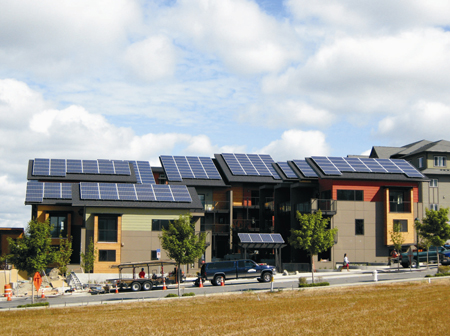
zHome
Architect: David Vandervort
Engineer: Harriott Smith Valentine Engineers
Owner: Ichijo Technological Homes
zHome is a 10-unit townhome that uses smart design and energy-efficient technologies to radically reduce each homeowner's environmental impact. It is believed to be the first multifamily community in the nation designed to reach net zero energy use.
The project team included the city of Issaquah, King County Solid Waste Division's GreenTools program, Puget Sound Energy, Port Blakely Communities, Washington State University and Built Green.
The sloped roofs of each townhome in the four-building development are covered with 240-watt solar panels, which provide much of each home's electricity. Each solar system generates surplus energy during the summer, which creates an electrical energy credit. Energy credits are used in the winter to supplement the lack of electricity being generated.
The photovoltaic system is grid-tied and uses SolarWorld modules and Enphase microinverters. Each microinverter attaches to the racking beneath the solar module and performs DC to AC power conversion on a per-module basis. Microinverters make each solar module an independent system, which provides performance advantages under shaded conditions and slight efficiency increases. Customers can monitor their system on a per panel level.
The townhomes use 70 percent less water than normal. zHome is the first community in the nation in which every home has earned the EPA's WaterSense label for new homes.
Each townhome uses the 50-degree temperature of the earth to pre-warm air coming into the house. This makes the all-electric heat three times more efficient than the typical residential forced air gas heating system. The solar array supports this design and further contributes to energy savings.
Project designers also paid rigorous attention to environmentally sound practices, ranging from building with low-toxicity finishes and recycled materials to installing rainwater storage tanks and charging stations for electric cars.
There were no time-loss incidents in the 1,046 hours worked during the project.